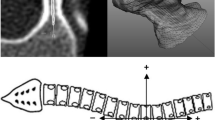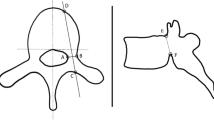Abstract
Purpose
Pedicles on the concave side of the proximal thoracic (PT) curve in adolescent idiopathic scoliosis (AIS) patients with Lenke II and IV deformities tend to be narrow and dysplastic, making pedicle screw (PS) insertion challenging. The aim of this study was to evaluate the feasibility for PS placement in these patients using pedicle chord length, diameter, and channel morphology.
Methods
In this retrospective study, 56 consecutive AIS patients with Lenke II or IV curves who underwent instrumented posterior spinal fusion (PSF) were studied. The mean age at surgery was 14.8 years and the mean PT curve measured 45°. Two independent investigators evaluated all visible pedicles from T1 to T6 vertebral levels using axial images from intraoperative computed tomography-guided navigation recording the pedicle: (1) maximum transverse diameter ‘d’ at the isthmus, (2) maximum chord length ‘l’, and (3) qualitative assessment of the channel morphology (types A–D).
Results
Two hundred and sixty-eight concave and 264 convex pedicles were measured. The mean ‘d’ of the concave pedicles at T3 and T4 was < 3.0 mm, compared to > 5.0 mm for the convex counterparts (p < 0.001). Of all concave pedicle channels, 48% had morphology characteristics that were riskier for PS cannulation (type C or D) compared to 2% of all convex pedicle channels (type A or B) (p < 0.001).
Conclusion
Almost half of all concave pedicles have morphologic characteristics that make them too small to accommodate a PS. Though PSs could be inserted using an in–out–in technique in these patients, alternative fixation anchors may improve strength and safety.




Similar content being viewed by others
References
de Kleuver M, Lewis SJ, Germscheid NM et al (2014) Optimal surgical care for adolescent idiopathic scoliosis: an international consensus. Eur Spine J 23(12):2603–2618. https://doi.org/10.1007/s00586-014-3356-1
Liljenqvist U, Lepsien U, Hackenberg L, Niemeyer T, Halm H (2002) Comparative analysis of pedicle screw and hook instrumentation in posterior correction and fusion of idiopathic thoracic scoliosis. Eur Spine J 11(4):336–343. https://doi.org/10.1007/s00586-002-0415-9
Lenke LG, Betz RR, Harms J et al (2001) Adolescent idiopathic scoliosis: a new classification to determine extent of spinal arthrodesis. J Bone Jt Surg Am 83(8):1169–1181. https://www.ncbi.nlm.nih.gov/pubmed/11507125
Gajaseni P, Labianca L, Kalakoti P, Pugely AJ, Weinstein SL (2020) Deformity correction using proximal hooks and distal screws (PHDSs) improves radiological metrics in adolescent idiopathic scoliosis. Eur Spine J. https://doi.org/10.1007/s00586-020-06442-3
Trobisch PD, Ducoffe AR, Lonner BS, Errico TJ (2013) Choosing fusion levels in adolescent idiopathic scoliosis. J Am Acad Orthop Surg 21(9):519–528. https://doi.org/10.5435/JAAOS-21-09-519
Suk SI, Kim WJ, Lee CS et al (2000) Indications of proximal thoracic curve fusion in thoracic adolescent idiopathic scoliosis: recognition and treatment of double thoracic curve pattern in adolescent idiopathic scoliosis treated with segmental instrumentation. Spine 25(18):2342–2349. https://doi.org/10.1097/00007632-200009150-00012
McLain RF, Ferrara L, Kabins M (2002) Pedicle morphometry in the upper thoracic spine: limits to safe screw placement in older patients. Spine 27(22):2467–2471. https://doi.org/10.1097/00007632-200211150-00009
Takeshita K, Maruyama T, Chikuda H et al (2009) Diameter, length, and direction of pedicle screws for scoliotic spine: analysis by multiplanar reconstruction of computed tomography. Spine 34(8):798–803. https://doi.org/10.1097/BRS.0b013e3181895c36
Lehman RA Jr, Polly DW Jr, Kuklo TR, Cunningham B, Kirk KL, Belmont PJ Jr (2003) Straight-forward versus anatomic trajectory technique of thoracic pedicle screw fixation: a biomechanical analysis. Spine 28(18):2058–2065. https://doi.org/10.1097/01.BRS.0000087743.57439.4F
Smorgick Y, Millgram MA, Anekstein Y, Floman Y, Mirovsky Y (2005) Accuracy and safety of thoracic pedicle screw placement in spinal deformities. J Spinal Disord Tech 18(6):522–526. https://doi.org/10.1097/01.bsd.0000154448.90707.a8
Papin P, Arlet V, Marchesi D, Rosenblatt B, Aebi M (1999) Unusual presentation of spinal cord compression related to misplaced pedicle screws in thoracic scoliosis. Eur Spine J 8(2):156–159. https://doi.org/10.1007/s005860050147
Qian B, Jiang J, Zhu F, Zhu Z, Liu Z, Qiu Y (2013) How is the trachea at risk of injury from pedicle screw insertion in proximal thoracic curve of adolescent idiopathic scoliosis patients? Eur Spine J 22(2):338–344. https://doi.org/10.1007/s00586-012-2520-8
Cardoso MJ, Helgeson MD, Paik H, Dmitriev AE, Lehman RA Jr, Rosner MK (2010) Structures at risk from pedicle screws in the proximal thoracic spine: computed tomography evaluation. Spine J 10(10):905–909. https://doi.org/10.1016/j.spinee.2010.08.020
Jiang J, Qian B-P, Qiu Y, Wang B, Yu Y, Zhu Z-Z (2016) The potential risk of left subclavian artery injury from excessively long thoracic pedicle screws placed in the proximal thoracic regions of Lenke type 2 adolescent idiopathic scoliosis patients and normal teenagers: an anatomical study. Eur Spine J 25(10):3282–3287. https://doi.org/10.1007/s00586-016-4569-2
Sarwahi V, Wendolowski SF, Gecelter RC et al (2016) Are we underestimating the significance of pedicle screw misplacement? Spine 41(9):E548–E555. https://doi.org/10.1097/BRS.0000000000001318
Gonzalvo A, Fitt G, Liew S et al (2015) Correlation between pedicle size and the rate of pedicle screw misplacement in the treatment of thoracic fractures: can we predict how difficult the task will be? Br J Neurosurg 29(4):508–512. https://doi.org/10.3109/02688697.2015.1019414
Privitera DM, Matsumoto H, Gomez JA, Roye DP Jr, Hyman JE, Vitale MG (2013) Are breech rates for pedicle screws higher in the upper thoracic spine? Spine Deform 1(3):189–195. https://doi.org/10.1016/j.jspd.2013.04.002
Kuraishi S, Takahashi J, Hirabayashi H et al (2013) Pedicle morphology using computed tomography-based navigation system in adolescent idiopathic scoliosis. J Spinal Disord Tech 26(1):22–28. https://doi.org/10.1097/BSD.0b013e31823162ef
Laine T, Lund T, Ylikoski M, Lohikoski J, Schlenzka D (2000) Accuracy of pedicle screw insertion with and without computer assistance: a randomised controlled clinical study in 100 consecutive patients. Eur Spine J 9(3):235–240. https://doi.org/10.1007/s005860000146
Flynn JM, Sakai DS (2013) Improving safety in spinal deformity surgery: advances in navigation and neurologic monitoring. Eur Spine J 22(Suppl 2):S131–S137. https://doi.org/10.1007/s00586-012-2360-6
Ughwanogho E, Patel NM, Baldwin KD, Sampson NR, Flynn JM (2012) Computed tomography-guided navigation of thoracic pedicle screws for adolescent idiopathic scoliosis results in more accurate placement and less screw removal. Spine 37(8):E473–E478. https://doi.org/10.1097/BRS.0b013e318238bbd9
Baky FJ, Milbrandt T, Echternacht S, Stans AA, Shaughnessy WJ, Larson AN (2019) Intraoperative computed tomography-guided navigation for pediatric spine patients reduced return to operating room for screw malposition compared with freehand/fluoroscopic techniques. Spine Deform 7(4):577–581. https://doi.org/10.1016/j.jspd.2018.11.012
Watanabe K, Lenke LG, Matsumoto M et al (2010) A novel pedicle channel classification describing osseous anatomy: how many thoracic scoliotic pedicles have cancellous channels? Spine 35(20):1836–1842. https://doi.org/10.1097/BRS.0b013e3181d3cfde
Landis JR, Koch GG (1977) The measurement of observer agreement for categorical data. Biometrics 33(1):159–174. https://www.ncbi.nlm.nih.gov/pubmed/843571
Taniguchi Y, Matsubayashi Y, Kato S, Ono T, Oshima Y, Tanaka S (2020) Preoperative assessment of the feasibility of pedicle screw insertion at the proximal thoracic curve in Lenke type 2 idiopathic scoliosis. Glob Spine J 10(3):261–265. https://doi.org/10.1177/2192568219844989
Chan CYW, Kwan MK (2018) Zonal differences in risk and pattern of pedicle screw perforations in adolescent idiopathic scoliosis (AIS): a computerized tomography (CT) review of 1986 screws. Eur Spine J 27(2):340–349. https://doi.org/10.1007/s00586-017-5350-x
Chan CYW, Kwan MK (2017) Safety of pedicle screws in adolescent idiopathic scoliosis surgery. Asian Spine J 11(6):998–1007. https://doi.org/10.4184/asj.2017.11.6.998
Jiang J, Mao S, Zhao Q et al (2012) Different proximal thoracic curve patterns have different relative positions of esophagus to spine in adolescent idiopathic scoliosis: a computed tomography study. Spine 37(3):193–199. https://doi.org/10.1097/BRS.0b013e3182285fb9
Krag MH, Beynnon BD, Pope MH, DeCoster TA (1988) Depth of insertion of transpedicular vertebral screws into human vertebrae: effect upon screw-vertebra interface strength. J Spinal Disord 1(4):287–294. https://doi.org/10.1097/00002517-198800140-00002
Weinstein JN, Rydevik BL, Rauschning W (1992) Anatomic and technical considerations of pedicle screw fixation. Clin Orthop Relat Res 284:34–46. https://www.ncbi.nlm.nih.gov/pubmed/1395312
Mohamad F, Oka R, Mahar A, Wedemeyer M, Newton P (2006) Biomechanical comparison of the screw-bone interface: optimization of 1 and 2 screw constructs by varying screw diameter. Spine 31(16):E535–E539. https://doi.org/10.1097/01.brs.0000225997.41924.eb
Lee CS, Cho JH, Hwang CJ, Lee D-H, Park J-W, Park K-B (2019) The importance of the pedicle diameters at the proximal thoracic vertebrae for the correction of proximal thoracic curve in Asian patients with idiopathic scoliosis. Spine 44(11):E671–E678. https://doi.org/10.1097/BRS.0000000000002926
Belmont PJ Jr, Klemme WR, Dhawan A, Polly DW Jr (2001) In vivo accuracy of thoracic pedicle screws. Spine 26(21):2340–2346. https://doi.org/10.1097/00007632-200111010-00010
Vaccaro AR, Rizzolo SJ, Balderston RA et al (1995) Placement of pedicle screws in the thoracic spine. Part II: an anatomical and radiographic assessment. J Bone Jt Surg Am 77(8):1200–1206. https://doi.org/10.2106/00004623-199508000-00009
Jeswani S, Drazin D, Hsieh JC et al (2014) Instrumenting the small thoracic pedicle: the role of intraoperative computed tomography image–guided surgery. Neurosurg Focus 36(3):E6. https://doi.org/10.3171/2014.1.FOCUS13527
Lien S-B, Liou N-H, Wu S-S (2007) Analysis of anatomic morphometry of the pedicles and the safe zone for through-pedicle procedures in the thoracic and lumbar spine. Eur Spine J 16(8):1215–1222. https://doi.org/10.1007/s00586-006-0245-2
Hassan E, Liau K-M, Ariffin I, Halim YA (2010) Internal morphometry of thoracic pedicles in the immature spine. Spine 35(13):1253–1256. https://doi.org/10.1097/BRS.0b013e3181c1172b
Zhang H, Sucato DJ, Nurenberg P, McClung A (2018) Morphometric analysis of vertebral growth using magnetic resonance imaging in the normal skeletally immature spine. Spine 43(2):133–140. https://doi.org/10.1097/BRS.0b013e3181c80ec5
Zhuang Z, Chen Y, Han H et al (2011) Thoracic pedicle morphometry in different body height population: a three-dimensional study using reformatted computed tomography. Spine 36(24):E1547–E1554. https://doi.org/10.1097/BRS.0b013e318210f063
Morales-Avalos R, Leyva-Villegas J, Sánchez-Mejorada G et al (2014) Age- and gender-related variations in morphometric characteristics of thoracic spine pedicle: a study of 4,800 pedicles. Clin Anat 27(3):441–450. https://doi.org/10.1002/ca.22359
Kim NH, Lee HM, Chung IH, Kim HJ, Kim SJ (1994) Morphometric study of the pedicles of thoracic and lumbar vertebrae in Koreans. Spine 19(12):1390–1394. https://doi.org/10.1097/00007632-199406000-00014
Huang J, Zhang P, Jian X, Jiang H (2018) The prevalence and distribution of vertebral pedicles in adolescent idiopathic scoliosis in CHINESE people: a computed tomography-based study of 2958 vertebral pedicles. World Neurosurg 119:e560–e567. https://doi.org/10.1016/j.wneu.2018.07.211
Datir SP, Mitra SR (2004) Morphometric study of the thoracic vertebral pedicle in an Indian population. Spine 29(11):1174–1181. https://doi.org/10.1097/00007632-200406010-00004
Funding
No funding was received for conducting this study.
Author information
Authors and Affiliations
Contributions
RHG, SLM, ARK, NSH, EJS, JMF: conception or design of work. RHG, SLM, ARK, NSH, EJS, JMF: acquisition, analysis, or interpretation of data for the work. RHG, SLM, ARK, NSH, EJS, JMF: drafting of work or revising it critically for important intellectual content. RHG, SLM, ARK, NSH, EJS, JMF: final approval of version to be published.
Corresponding author
Ethics declarations
Conflict of interest
The authors have no conflict of interest to declare that are relevant to the content of this article.
IRB approval
This study was approved by the Institutional Review Board at the Children’s Hospital of Philadelphia.
Additional information
Publisher's Note
Springer Nature remains neutral with regard to jurisdictional claims in published maps and institutional affiliations.
Rights and permissions
About this article
Cite this article
Guzek, R.H., Mitchell, S.L., Krakow, A.R. et al. Morphometric analysis of the proximal thoracic pedicles in Lenke II and IV adolescent idiopathic scoliosis: an evaluation of the feasibility for pedicle screw insertion. Spine Deform 9, 1541–1548 (2021). https://doi.org/10.1007/s43390-021-00377-5
Received:
Accepted:
Published:
Issue Date:
DOI: https://doi.org/10.1007/s43390-021-00377-5




